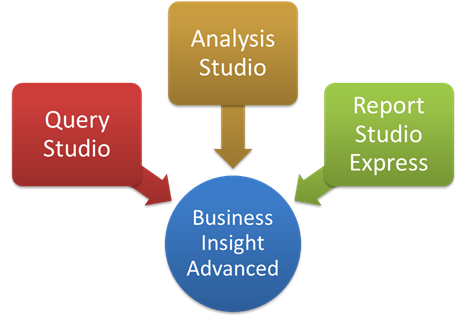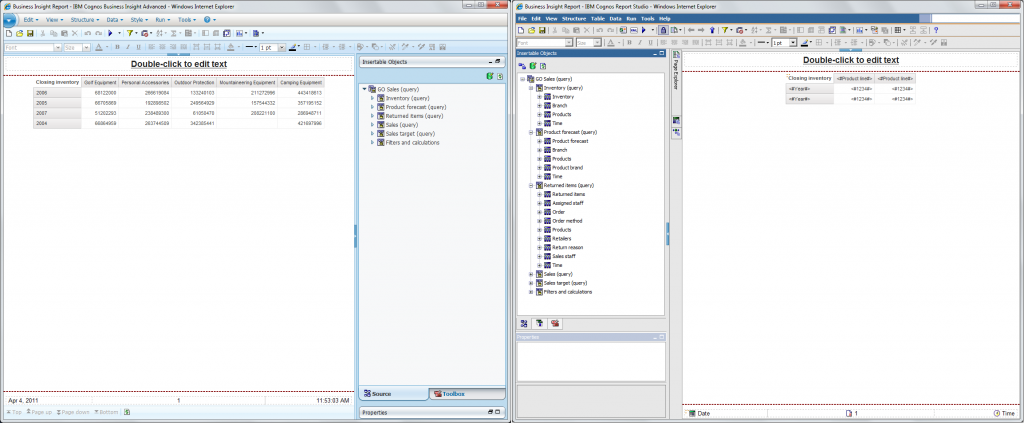IBM Cognos 10 Business Insight Advanced: 5 Key Features that Can Transform Your Organization
Back in October when IBM Cognos 10 was first released, I initially touted Business Insight Advanced (BIA) as the single-most important enhancement over IBM Cognos 8. After a few months of hands-on usage, I am sticking to my initial assessment. Here are five key features that I’ve identified as having the greatest potential for a positive impact on practical business intelligence within most organizations.
One Studio for Everything
Prior to IBM Cognos 10, when a Cognos user wanted to create an ad-hoc report and their environment consisted of a mix of OLAP, Multidimensional and/or Relational data sources, they had to be aware of these underlying differences in order to select the studio that best suited the type of reporting they were looking to do. For fast, simple multidimensional analysis you would use Analysis Studio, and for tabular or detailed querying of relational data sources you would select Query Studio. If you wanted to create more complex reports based upon multidimensional data sources, a third option, Report Studio Express Authoring Mode was the instrument of choice. The act of choosing the appropriate tool for the job was neither complex nor time consuming in itself, but getting to that point organizationally meant training users on up to three different tools with three different user interfaces.

With the introduction of Business Insight Advanced, you or your users will no longer need to take into account the type of underlying data source or package before selecting a working environment. OLAP, Relational or Multidimensional – It no longer matters. Simply launch Business Insight Advanced and start authoring rich reports without any need for understanding the complexities of the underlying technology. All of the functionality of Analysis Studio, Query Studio, Report Studio Express, and more, have been condensed into Business Insight Advanced.
If your organization’s Business Intelligence Competency Center (BICC) develops and delivers their own training curriculum to empower their users and extract maximum value from their investment, consider how you can rapidly shorten your deployment and training process by focusing on only a single studio that is simultaneously more powerful and intuitive than its predecessors. The result is a population of end users who have spent less time in training and are more empowered and effective than ever before.
Pulling Out the Stops for Power Users
When working with our clients we often encounter situations where power users have outgrown the usefulness of either Query Studio or Analysis Studio and clamoring for more functionality. This is an encouraging problem to have because it means our power users are very well versed with the tools and is an excellent indicator that we are getting a great return on our investment in the solution. The next evolutionary step for these users would be an introduction to Report Studio. What we’ve found in practice is that the technological gap between the ad-hoc studios and the professional authoring studio is larger than anticipated, and some have struggled to make the jump despite their higher level of proficiency with the other studios.
Business Insight Advanced removes the handcuffs for these power users, and empowers then to create complex, rich, professional looking reports without layering in any of the complexity of Report Studio or steepening its own learning curve. A few of the advanced features that BIA offers over its predecessors are:
- The ability to create reports with multiple query objects (Charts, Lists, Crosstabs)
- The ability to modify report format and layout in ways previously only available to Report Studio users.
- Access to the entire suite of report functions, permitting you to create complex calculations just as you can in Report Studio.
- The ability to use all of the new charting options available in Cognos 10, right from BIA.
- The power to integrate data from external spreadsheets on the fly.
All of the added functionality has been intuitively integrated into BIA, allowing curious users to peek under the covers and do more when they are willing and ready.
Bridging the Gap between Power User and Professional Author
For self-service oriented users, the hurdle of learning two disparate ad-hoc reporting tools in Query Studio and Analysis Studio (however simple they may be) has traditionally steepened the near end of the learning curve. As was mentioned earlier, BIA has remedied this by bringing together all of this functionality and more into a single, unified studio.
What is most interesting, and has been often overlooked by many analysts and observers is that the general experience of a Business Insight Advanced user is reflective of the Professional Authoring environment, Report Studio. The somewhat intangible benefit of this is once again, simplifying the training process and rapidly shortening time it takes a user to be proficient and effective within the broader toolset.
Whereas Query Studio and Analysis Studio were distinctly different user experiences from each other, and Report Studio; Business Insight Advanced is positioned as a natural and intuitive stepping stone to Report Studio. The look, feel, and development workflow, coupled with optional access to dive deeply into many of the advanced reporting functions that were previously only available within Report Studio means that BIA can now be used to further bridge the gap between a traditional Power User and the concept of the Professional Author.
Integrating External Data
The general theme of the 2010 TDWI World Conference in San Diego was “Creating an Agile BI Environment”. In 2011, this theme continues with “Evolving your Agile BI Environment.” The industry as a whole has spoken – we need to be able to get answers faster, and en route to those answers, be more able to cope with evolving requirements. Furthermore we need to be understanding of the fact that sometimes this evolution comes at the expense of quality control early on in the process.
In response to this overall push for rapid development and evolution of analytical requirements, with release of Cognos 10, we’ve been given the ability to upload and integrate local data from our own spreadsheets on-the-fly and marry it with data from existing packages. Even more exciting is that this incredibly powerful feature is enabled in not only Report Studio, but also Business Insight Advanced.
To no surprise, we have found the proposition of such a feature to be somewhat polarizing across a diverse group of stakeholders. End users are typically excited at the prospect of being able to integrate their spreadsheet data in a more structured manner. IT and Information Management support personnel recoil at the notion of “unauthorized” or “unclean” data being served out of their certified application environment. Fortunately we believe there is some middle ground.
The reality is that users have been bringing together their own spreadsheets with enterprise data and redistributing the results since the dawn of Excel. Depending on your organization’s analytical culture and with the appropriate policies in place, we believe that this feature can be a very effective tool for prototyping new solutions as well as uncovering and rapidly evolving new requirements well before the traditional development process would begin.
Cross Compatibility with Report Studio
For administrators or professional authors who work closely with power users during their development cycles, this new feature will be well received. In Cognos 8, reports developed in either Query or Analysis Studio could be opened using report studio, but any modifications made in that environment could not be saved back to the original ad-hoc view. With Business Insight Advanced, there is now full cross compatibility between reports developed in the two studios. Reports developed in Report Studio can be opened, edited and saved within Business Insight Advanced, and vice versa. This further blurs the line between Power User and Professional Author, encourages cross training and collaboration between those roles organically and extends the usefulness of content developed in either environment.
Next Steps
If you’re interested in learning more about how Business Insight Advanced can help to evolve self-service business intelligence at your organization, or if you’d like discuss our proven IBM Cognos 10 upgrade methodology that allows you to consolidate and simplify your environment by leveraging BIA, please Contact Us today.



